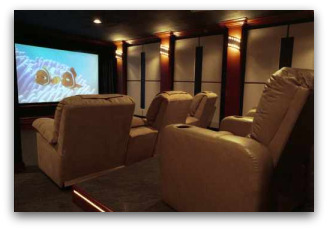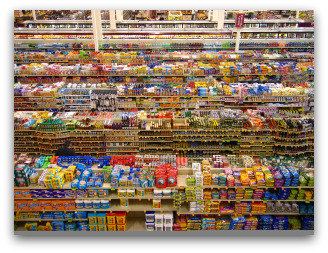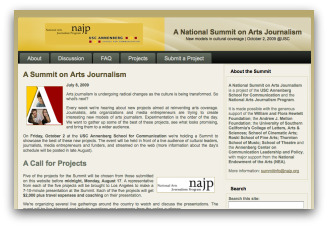Douglas McLennan: July 2009 Archives
The latest new-generation movie megaplex recently opened near us. It's got stadium seating,

reclining extra-wide luxurious seats with cup holders in the armrests, and so much legroom you could park a Winnebago. A couple of the 14 screens in the megaplex are Imaxes that surround you with giant images and wrap you in sound. In the lobby they sell real food, the kind you might conceivably want to consider eating. All in all, the experience is a treat, one that elevates the ritual of going to a movie (ugly outside architecture notwithstanding).
In the 1990s we spent $25 billion on new concert halls, theaters and museums in America. Handsome buildings most of them. One thing though. While much of the exterior architecture tries to be distinctive (Disney Hall being an obvious example) the insides (Disney an exception) are for the most part entirely predictable. And despite the fact that the average concert hall was many times more expensive to construct than the new-generation movie complexes, the customer amenities inside the halls constructed over the past 20 years - how can I put this kindly - kind of suck.

Narrow aisles, cramped leg room, utilitarian seats that if not uncomfortable are hardly luxurious. There's an austere formality to the rows of perches lined facing the stage. Nothing particularly wrong with formality. And many of the auditoriums are pleasant enough to be in. But how is it that virtually all of the halls built in this era more or less follow the same bare aesthetic when it comes to amenities?
The movie theatre industry realized with the explosion of infinite choice that they had to compete to make the theatre experience competitive with the home flat screen and surround sound. They had to make the live experience of watching a movie in public a better deal. At a minimum that meant making the watching experience as comfortable as possible, then delivering state-of-the-art picture size and quality.
There's an argument to be made for preserving formal rituals in going out to see a performance. But things change. I like some of the rituals, but I have to admit I often resent the degree to which it is imposed by rigid seats and cramped legroom. And why can't I bring my drink back in to the show? Some theatres just work better as formal spaces. But others? The fact that there seems so little innovation or re-thinking of the physical experience of going to concerts seems like a missed opportunity.Recently, Adam Kenwright, who markets West End shows in London, said that the uncomfortable seats and poor amenities in West End theatres was seriously deterring people from buying tickets to shows.
Tickets to arts performances can cost many times more than movie tickets. Yet from an amenity experience, there's no question which is the first-class seat and which is steerage economy.
The new generation of baseball stadia are amenitiy-rich. The new generation of coffee shops (Starbucks, et al) concentrate a lot of their resources in developing customer amenities. Go to a House of Blues or other perfoming spaces such as LA's Knitting Factory, and the seats are removed altogether or pushed to the sides. People rock out while the performer is on. I'm not saying take out the seats, but if movie theatre owners figured out they had to deliver a better seating experience to compete, doesn't it follow that the performing arts ought to consider how they could upgrade?
But this is wrong. The mushy middle is nobody's favorite, it's merely the version that the most people will tolerate. Furthermore, the characteristics don't really match consumers' true preferences. You're asking for opinions which are not based on individual research. People often don't know what they want until you tell them and they're happier when you do. We know this in the arts. Inspire with something great and unexpected and people will cheer. Arts organizations that follow the crowd rather than lead are not only less interesting, but they get hooked into a feedback loop that leads to artistic rot.
Note in Gladwell's story that some choice leads to happier customers. For the flip side and a cautionary tale about choice, watch sociologist Barry Shwartz's talk about the tyranny of choice. If choice is good and we can more and more get what we want, why do we seem less satisfied with our choices? He suggests that too much choice is paralyzing and leads to incoherent decisions. Choices inflict the work of having to evaluate and choose. Choices set up higher expectations which are difficult to meet. Consequently we are less satisfied.
As an example, Schwartz cites employer 401k plans. When employees are offered few choices they invest in the programs. Plans with a high number of investment choices see much less employee participation, even though the plans directly benefit those who join. Why? Too hard to choose. Fear of making a bad choice results in paralysis.
Extrapolate this paralysis out to cultural choice. How are you sorting out the noise? We look for trusted guides who can sort it out for us and give us a framework that makes sense. Narrow the choices down to two or three best possibilities and I'm grateful. This is a dynamic that has tangible currency in the Attention Economy.
 I was a bit surprised by some of the reaction to my last post on the unsustainability of the ticket sales model in the Attention Economy. Boil down my argument and it's essentially this: products used to compete primarily with other products in their sector. Jazz competed with other jazz, dance competed with other dance. In the Attention Economy, dance competes with video games competes with YouTube videos competes with online courses from MIT competes with the Cuban Hooked Rug Society Online. The typical consumer transaction decision is a weighing of the available options at the point of sale and buying based on the needs/desires of the moment. Given infinite choice and a rising complexity in figuring out what one wants, getting people to pay attention to what you have to offer is increasingly problematic.
I was a bit surprised by some of the reaction to my last post on the unsustainability of the ticket sales model in the Attention Economy. Boil down my argument and it's essentially this: products used to compete primarily with other products in their sector. Jazz competed with other jazz, dance competed with other dance. In the Attention Economy, dance competes with video games competes with YouTube videos competes with online courses from MIT competes with the Cuban Hooked Rug Society Online. The typical consumer transaction decision is a weighing of the available options at the point of sale and buying based on the needs/desires of the moment. Given infinite choice and a rising complexity in figuring out what one wants, getting people to pay attention to what you have to offer is increasingly problematic. I don't think the the answer to infinite choice is anything new. We're most comfortable choosing things on the basis of relationships, and any good sales person knows this. In the past, building relationships was an analog task; social networks take it digital. This is a good thing
What surprised me is that Andrew and Kelly and others who emailed seemed to suggest that this is something of an either/or notion; that to implement a community-building strategy either requires taking focus off of traditional efforts to sell tickets or involves some risk to current strategy. As Kelly Tweeddale puts it:
What would you do differently if the transaction was the outcome, not the goal? Our current non-profit model does not provide a financial safety net for such bold thinking or experiments, but it should. Any early adopters?Andrew Taylor suggests that:
The deeper challenge for arts organizations is that they DO sell a product, even as they DON'T. That is, an important segment of any arts audience doesn't recognize the complex bundle they're seeking when they buy a symphony or theater ticket. They've come to use that event as a placeholder or proxy for that bundle, without even knowing it. To this core group (often the most passionate about the art form, the most loyal buyers, the most committed donors) the bundle IS the product. And as you innovate around the delivery or context of your creative work, you challenge their passionate connection to the discipline's tradition.The shift to the Transportation Economy Model didn't mean there was no need for manufacturing. The Experience Economy doesn't negate access to product in a timely way. And the Attention Economy assumes a robust Experience, Transportation and Manufacturing infrastructure. Product is assumed; without it, you're not even in the game.
So how do you implement an Attention strategy? Here are five ideas:
1. Set up a ladder of involvement that rewards increased participation. Come to every performance and maybe you get a free ticket to give to a friend. Bring in a dozen friends and you get your name in the program. Organize a club around our programming and maybe you get an insider pass to see how next season's lineup is put together. We reward people who donate money to our theatre; how about rewarding those who go out and bring in new recruits? Maybe membership on your board is one of those upper rungs of participation. The participation incentive ladder doesn't have to be formally structured like affiliate programs, but you get the idea...
2. Community isn't free. Every time someone decides to interact with you, you have to reward them in some way. Even clicking a mouse (believe it or not) requires a reward. Ninety-nine percent of web visitors are lurkers. That is, they come, they read, they say "Gee, that's interesting," and they move on. Same with those who come to performances. Why should I come to a post-concert chat? You have to do something to provoke me into a response. That response is worth something. That response must be rewarded in some way. Especially if it's a complaint.
3. These kinds of communities are extremely hierarchical. They don't want to be paid in money. They want status. Recognition. Validation. It can be as simple as identifying somebody as a friend of the organization. Reward them for answering other community members' questions. Cruise lines, for example, give repeat cruisers different color cabin key cards based on how many times they've come aboard. Those cards are status markers, and the community pays attention to them. Tech support in big online communities has largely become a community function. The community is better at solving its own problems, and people who log in with answers are accorded higher status by others in the community. This is a powerful driver of participation.
4. Twenty percent of your seats are unsold? What a waste. Create a club that gives members access to cheap surplus tickets with which they can bring others. Those companies (airlines, are you listening?) that throw up barriers to upgrades make members feel like the company doesn't want you to have a good experience. Be over-generous. Your community will feel like they owe you for it. And that generosity doesn't necessarily have to cost you anything.
5. Find ways to give people in your community opportunities to support you. I might not have enough money to give you a donation. But if you ask, I might bring a group of friends to the next concert. I might not have time to serve on your board, but I might know a good printer who could give you a break on programs. Public radio is available for free, but enough listeners value it so much that they're willing to give money to support it. We're not very creative about the ways we ask for support.
The American arts economy is run as though we're still living in the Manufacturing Economy or the Transportation Economy. That is, most arts organizations and artists believe they're in the business of making things.
Of course they make things. But these days everybody makes things. There's an abundance of everything out there, so making things, even if they're very very good, means less than it did 30 years ago because there are many other very very good things to choose from.
In the Transportation Economy, scarcity dictated opportunity, and getting the word out about a product could build an audience. In the Attention Economy where we can get what we want when we want and how we want it (metaphorically, if not in actuality) we grab for what inserts itself in our path. The issue isn't access, it's overload. How do we sort out things we want from the overwhelming mass of "stuff" that engulfs us?
 If you believe your business model is the classic consumer transaction (I make the performance, you buy the ticket) then you're done. Sorry. That's a Manufacturing Economy mindset, and while it worked when choices were limited, now that you're competing in the infinite marketplace offering 8000 or 8 million choices, it's increasingly unlikely that your "audience" is going to choose you as often as they did in the past.
If you believe your business model is the classic consumer transaction (I make the performance, you buy the ticket) then you're done. Sorry. That's a Manufacturing Economy mindset, and while it worked when choices were limited, now that you're competing in the infinite marketplace offering 8000 or 8 million choices, it's increasingly unlikely that your "audience" is going to choose you as often as they did in the past.In the Attention Economy it isn't enough to be the best orchestra or theatre or dance company. People aren't comparing you with other orchestras or theatre or dance companies; they're measuring whether classical music or theatre or dance is something they want to choose at the moment. They're deciding whether they want an active or passive experience; they're trying to determine what level of social encounter they feel like today. They're weighing whether they want a predictable, known, comfortable quantity or whether they want to be adventurous and try something new. They're figuring out whether they want to learn something and are willing to work for that or whether they're looking for pure entertainment that costs them little. Price matters - if it's going to cost, it's got to be better than the free alternative. It doesn't matter that there are 47 varieties of spaghetti sauce on the shelf in front of me if what I really want is pesto.
The choice is bewildering. Paralyzing, even. You can't compete with such overwheming choice with a consumer transaction model, no matter if you're the Philadelphia Orchestra, the Metropolitan Opera or the Guthrie Theatre.
One of the big lessons of social media is that community matters. A lot. People make their choices about culture based on their community. Peer word-of-mouth is a much more powerful driver of cultural choice than newspaper reviews or advertising. How do you fight infinite choice? Build community rather than audience. Give people reasons to engage with you, care about you, so when they're making choices it's more than just a consumer transaction. Nothing new about this. Amway, the mega-churches, the Barack Obama campaign all understand this.
 In the past couple of years, half of all the staff arts journalism jobs in the US have been eliminated. In some cases, newspapers offloading their staff critics have replaced them with freelancers. In some cases, the freelancers have done a better job than the staffers they have replaced. But mostly not.
In the past couple of years, half of all the staff arts journalism jobs in the US have been eliminated. In some cases, newspapers offloading their staff critics have replaced them with freelancers. In some cases, the freelancers have done a better job than the staffers they have replaced. But mostly not.Running a good freelance section requires editors who have the time and talent to know what's going on in the culture of their community, who are out listening for the stories they should be assigning. Most editors are even busier just trying to fill their sections than they were when they had staff critics paying attention to their beats. They don't also have time to be out trolling for stories.
And the way editors are moved around in newspapers, as time goes on, good freelance coverage wanes in favor of stories that are easier to do and have more immediate pop. Having someone whose paid job it is to cover a beat means a different level of scrutiny; covering culture in an ad hoc way means the coverage doesn't necessarily connect up stories over time.
So it's clear that the trend will continue to be a diminution in the amount and quality of arts coverage in newspapers even in the face of heroic efforts by remaining staff to do good work.
Traditional arts journalism did a great job - when it was practiced well - of covering certain kinds of art. Still does. Unfortunately, a great deal of arts journalism is poorly done. Over the past 20 years the pressure to concentrate on the consumer review function has trivialized much coverage. And the inability of most publications to develop longer story arcs that speak to a broader context has marginalized it. In an increasingly crowded cultural space, the traditional emphasis on the review as the primary form is suicide.
Moreover, traditional arts journalism never did particularly well at covering some kinds of culture. Coverage of dance, for example, was never very plentiful or imaginative. We never did figure out interesting ways to cover participatory community culture, which involves and engages enormous numbers of people. The old model of experts preaching to "the masses" had tenuous hold of an audience long before the internet came along. And in an expanding cultural universe, the scattershot way culture has been covered has been increasingly difficult to justify.
In short, the model we have used for arts journalism, the model that was developed in the 19th Century, has outlived its potency. It was broken long before the internet, and it probably wasn't going to evolve significantly until the structures (publications) that supported it could no longer do so. It's time for a change, and about time it happened.
So if the old model of arts journalism needs an overhaul, and the business model that has supported it no longer works, what's next? All over the country artists and journalists and entrepreneurs are trying to figure it out. Dozens of projects have launched in recent months, and Technorati currently counts 300,000 arts blogs.
Which ones are worth paying attention to? Which are not just interesting projects, but viable ones as well?
So the Annenberg School for Communication at USC and the National Arts Journalism Program, of which I am the director, are holding a summit on the future of arts journalism October 2. We're looking for projects that are trying to become that brilliant next model. We'll be showcasing ten projects, five of them chosen by competition. Each of those chosen for the summit will make ten-minute presentations to explain why they're great. The summit will be live-streamed and archived for later viewing. There is $25,000 in prizes for winning projects, plus lots of attention. Thanks to the NEA, the Andrew W. Mellon Foundation, the Flora & William Hewlett Foundation and arts and journalism schools at USC for their generous support.
So if you have the answer for what will be the next great arts journalism model, we'd love to find out more about it. Go here to apply.
AJ Ads
AJ Blogs
AJBlogCentral | rssculture
Terry Teachout on the arts in New York City
Andrew Taylor on the business of arts & culture
rock culture approximately
Laura Collins-Hughes on arts, culture and coverage
Richard Kessler on arts education
Douglas McLennan's blog
Dalouge Smith advocates for the Arts
Art from the American Outback
For immediate release: the arts are marketable
No genre is the new genre
David Jays on theatre and dance
Paul Levy measures the Angles
Judith H. Dobrzynski on Culture
John Rockwell on the arts
Jan Herman - arts, media & culture with 'tude
dance
Apollinaire Scherr talks about dance
Tobi Tobias on dance et al...
jazz
Howard Mandel's freelance Urban Improvisation
Focus on New Orleans. Jazz and Other Sounds
Doug Ramsey on Jazz and other matters...
media
Jeff Weinstein's Cultural Mixology
Martha Bayles on Film...
classical music
Fresh ideas on building arts communities
Greg Sandow performs a book-in-progress
Exploring Orchestras w/ Henry Fogel
Harvey Sachs on music, and various digressions
Bruce Brubaker on all things Piano
Kyle Gann on music after the fact
Greg Sandow on the future of Classical Music
Norman Lebrecht on Shifting Sound Worlds
publishing
Jerome Weeks on Books
Scott McLemee on books, ideas & trash-culture ephemera
theatre
Wendy Rosenfield: covering drama, onstage and off
Chloe Veltman on how culture will save the world
visual
Public Art, Public Space
Regina Hackett takes her Art To Go
John Perreault's art diary
Lee Rosenbaum's Cultural Commentary
Tyler Green's modern & contemporary art blog
AJ Blogs
AJBlogCentral | rssculture
Terry Teachout on the arts in New York City
Andrew Taylor on the business of arts & culture
rock culture approximately
Laura Collins-Hughes on arts, culture and coverage
Richard Kessler on arts education
Douglas McLennan's blog
Dalouge Smith advocates for the Arts
Art from the American Outback
For immediate release: the arts are marketable
No genre is the new genre
David Jays on theatre and dance
Paul Levy measures the Angles
Judith H. Dobrzynski on Culture
John Rockwell on the arts
Jan Herman - arts, media & culture with 'tude
dance
Apollinaire Scherr talks about dance
Tobi Tobias on dance et al...
jazz
Howard Mandel's freelance Urban Improvisation
Focus on New Orleans. Jazz and Other Sounds
Doug Ramsey on Jazz and other matters...
media
Jeff Weinstein's Cultural Mixology
Martha Bayles on Film...
classical music
Fresh ideas on building arts communities
Greg Sandow performs a book-in-progress
Exploring Orchestras w/ Henry Fogel
Harvey Sachs on music, and various digressions
Bruce Brubaker on all things Piano
Kyle Gann on music after the fact
Greg Sandow on the future of Classical Music
Norman Lebrecht on Shifting Sound Worlds
publishing
Jerome Weeks on Books
Scott McLemee on books, ideas & trash-culture ephemera
theatre
Wendy Rosenfield: covering drama, onstage and off
Chloe Veltman on how culture will save the world
visual
Public Art, Public Space
Regina Hackett takes her Art To Go
John Perreault's art diary
Lee Rosenbaum's Cultural Commentary
Tyler Green's modern & contemporary art blog

Recent Comments